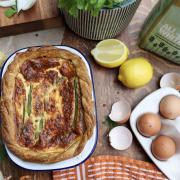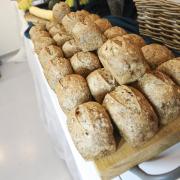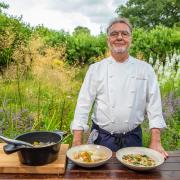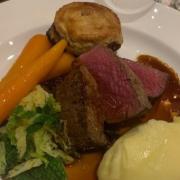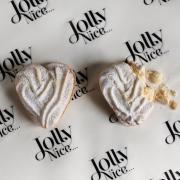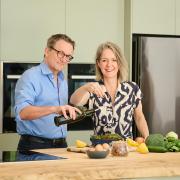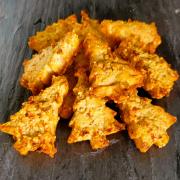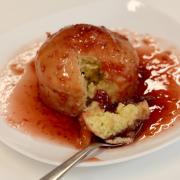Not your ordinary rainbow cake, this lemon sponge with fresh fruit decoration is perfect for a children’s birthday party or just to brighten up a rainy day

This colourful cake looks spectacular but is very simple to make. You can use a ring-shaped savarin tin to bake the cake, but I quite like the DIY approach of putting an empty golden syrup tin inside a round cake tin – a pot of gold in more ways than one. Either way, with its clouds of cream and rows of glistening, lemon-glazed fruit, this bake will ‘rain’ supreme!

Makes a 23cm cake
Serves 6–8
Ingredients
For the cake
• Cake-release spray for the tin
• 100g butter, softened
• 100g caster sugar
• 2 lemons
• 2 eggs (at room temperature)
• 100g self-raising flour
• 2 tbsp ground almonds
For the lemon syrup
• 100g caster sugar
To decorate
• 300ml double cream
• 1 kiwi fruit
• 1 mango
• 150g strawberries
• 50g blueberries
Equipment
• 23cm round, deep, loose-bottomed
• Tin,
• Greased and fully lined
• Empty golden syrup tin (454g size)
• Cocktail stick
• Medium paintbrush
1. Preheat the oven to 180°C/160°C fan/gas 4. Lightly grease the outside of the syrup tin with cake-release spray, then wrap it in baking parchment. Place it in the centre of the lined round tin.
2. Using a hand-held electric whisk, or in a free-standing mixer, beat the butter and sugar together for 5–10 minutes or until very light, pale and creamy. Grate the zest from the lemons into the mix and beat it in.
3. Lightly beat the eggs in a mug or jug. Gradually add the egg to the butter and sugar mixture, beating well after each addition. If the mixture looks like it’s curdling, add a spoonful of the flour. Sift the flour and almonds into the mixture, in batches, folding in each batch until just combined.
4. Squeeze all the juice from the lemons. Gently stir 2 tablespoons of the juice into the cake mixture. Set the rest of the juice aside.
5. Spoon the cake mixture into your tin, taking care to keep the syrup tin central as you spread the mixture around it. Bake for 20–25 minutes or until the cake is risen and lightly golden brown, and a skewer inserted into it comes out clean.
6. While the cake is baking, make the lemon syrup. Measure the reserved lemon juice and add water, if necessary, to make it up to 100ml. Pour into a saucepan. Add the caster sugar and set the saucepan over a medium-high heat. Warm for several minutes, stirring occasionally, until the sugar has dissolved, then remove from the heat and allow to cool.
7. Once the cake is baked, and while it is still warm, prick the surface all over with the cocktail stick. Brush over some of the lemon syrup using the paintbrush or a pastry brush, allowing the syrup to soak into the sponge. Set aside the remaining syrup to glaze the fruit later.
8. Leave the cake to cool slightly before carefully lifting out the syrup tin. Set the cake, still in its round tin, on a wire rack to cool completely.
9. Remove the cooled cake from the tin. Using a ruler as a guide, cut the cake across in half to make two rainbow shapes.
10. Whip the cream with a hand-held electric whisk until it forms soft-to-medium peaks. Using a small palette knife, spread half the cream over each rainbow-shaped cake, creating a slightly textured finish. Place one cream-covered rainbow cake on top of the other.
11. Cut the top and bottom off the kiwi fruit, then slice the skin away in strips. Use a small, sharp knife to peel the mango, then slice the flesh off the central stone in large pieces; you’ll only need about half of this, depending on the mango’s size. Cut the kiwi, mango and strawberries into neat 1–2cm pieces.
12. Arrange all the pieces of fruit on top of the cake in neat rows, to create the appearance of a rainbow. Brush the remaining lemon syrup over the fruit as a glaze. (Any leftover syrup can be kept in the fridge for up to a week and used to flavour other cakes.)
Variation
I also like to present the finished cake on a slate board that is dusted with icing sugar clouds, made by sifting icing sugar over a cloud stencil (use the cloud template shape on p.213 to cut a stencil from a sheet of card). To add to the display, fill a golden syrup tin with lemon drops and gold chocolate coins and put it at the end of the rainbow cake to represent the pot of gold.
Extract taken from Quinntessential Baking by Frances Quinn (Bloomsbury £25.00)
Photography © Georgia Glynn Smith
Like this? Read the interview with Frances Quinn.
If all this talk of baking has got you running for the kitchen, head over to Great British Life to find the best baking accessories.






